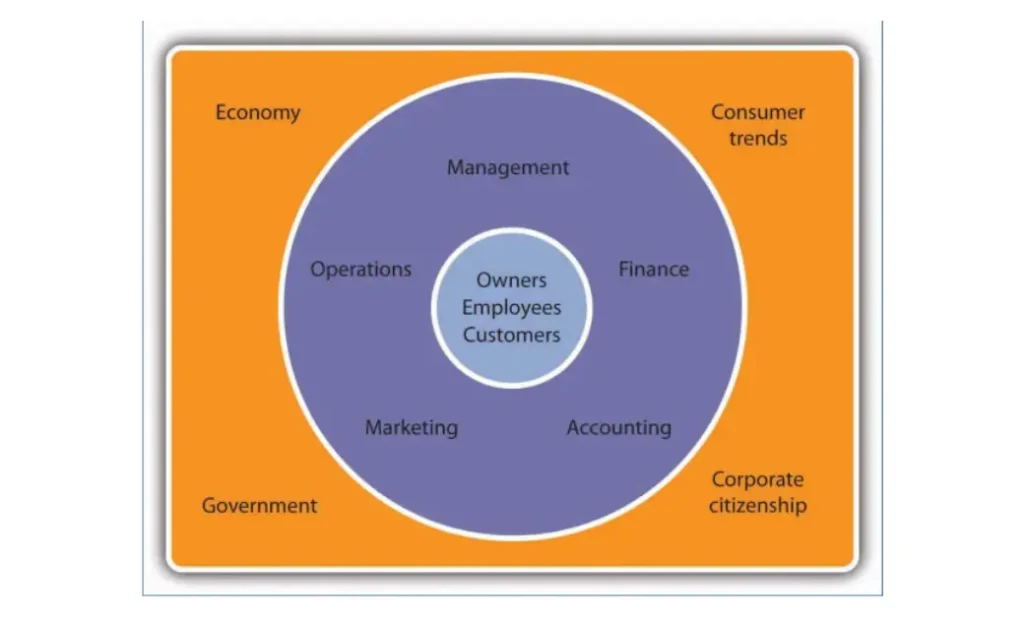A business refers to any enterprise that offers products or services to consumers with the intention of generating a profit. When Steve Jobs and Steve Wozniak launched Apple Computer from Jobs’s family garage, they embarked on a business venture. Their product, the Apple I, was intended to be sold to customers at a price higher than its production and marketing costs, thereby earning a profit.
Before moving ahead, it is essential to differentiate between the terms used in our definitions. While Apple produces and sells goods like the iPhone, iPod, and Mac, many businesses offer services. Your bank and internet service provider are examples of service providers. Airlines, law firms, movie theaters, and hospitals are also categorized as service providers. Many companies provide both goods and services, such as your local car dealership, which offers both cars and automobile repair services.
Additionally, some organizations are not designed to make profits, such as those providing social or educational services. These not-for-profit or non-profit organizations include the United Way of America, Habitat for Humanity, the Boys and Girls Clubs, the Sierra Club, the American Red Cross, and many universities and colleges. However, these organizations function in a similar way to a business, establishing objectives and working towards achieving them efficiently and effectively. As a result, most business principles discussed in this text also apply to nonprofits.
Business Participants and Activities
To initiate our discourse on business, we will first identify the primary players in business and the functions they undertake. Subsequently, we will conclude this segment by examining the external factors that impact a business’s operations.
Participants
Each business is obligated to have at least one owner who plays a fundamental role in investing capital into the company. During the business’s inception, it is typically the owners who refine the business concept and assemble the necessary resources, including finances and personnel, to transform the idea into a functioning business. The owners are also responsible for recruiting employees to work for the company and contribute to achieving its objectives. Owners and employees rely on a third group of participants, namely customers, who are vital to the business’s success. Ultimately, the primary objective of any business is to meet the demands and requirements of its customers.
Functional Areas of Business
The functions necessary to run a business can be categorized into several areas: management, operations, marketing, accounting, and finance. We will briefly examine each of these domains.
Management
The duty of managers is to oversee the job performance of others. Management encompasses the process of planning, organizing, staffing, directing, and controlling a company’s resources to achieve its objectives. Managers engage in planning by setting goals and formulating strategies to accomplish them. They organize operations and resources to guarantee that company goals are met, staffing the organization with competent employees, and guiding them to achieve the organizational objectives. Ultimately, managers develop controls to evaluate the effectiveness of decisions and plans, taking corrective measures whenever necessary.
Operations
Every organization is required to transform resources (such as labor, materials, money, information, etc.) into goods or services. While some companies, like Apple, produce physical products such as iPhones, iPods, and Macs, others like hospitals provide intangible products, such as healthcare services. The operations manager is responsible for designing and overseeing the process of converting resources into goods or services, regardless of the type. This individual is also responsible for ensuring that the produced products or services are of excellent quality.
Marketing
Marketing involves all activities that a company undertakes to identify customers’ needs and develop products that meet those needs. Marketers are responsible for determining the benefits and features of products, including price and quality. They also determine the most effective delivery methods and promotional strategies to attract and retain customers. By managing relationships with customers, marketers strive to create awareness of the organization’s commitment and ability to satisfy customers’ needs.
Accounting
Managers require precise, pertinent, and timely financial information, which is provided by accountants. Accountants are responsible for measuring, summarizing, and communicating financial and managerial information to advise other managers on financial matters. There are two major fields of accounting. Financial accountants prepare financial statements to assist both internal and external users in assessing the financial stability of the company. Managerial accountants, on the other hand, generate information such as reports on the cost of materials used in the production process, which are intended for internal use only.
Finance
The field of finance deals with the planning, procurement, and management of a company’s financial resources. Finance managers are responsible for answering critical questions such as the following: How much money does the company require? What is the source of the required funds and how can they be obtained? What is the repayment schedule for the borrowed funds? What are the best investment options for the company’s resources? How much should be allocated for research and development? What should be done with excess funds? Effective financial management is crucial for new businesses, as owners usually need to seek external funding to get started.
External Forces That Influence Business Activities

Businesses like Apple are not isolated entities as they are impacted by various external factors such as the economy, government policies, consumer preferences, and societal expectations of being a responsible corporate entity. Image “Business and Its Environment” depicts how the participants in a business, its functional areas, and external forces interrelate to influence its operations. The fast-food industry is a prime example of how all these factors can affect a business. The economy plays a role in people’s ability to dine out and food standards that are monitored by the Food and Drug Administration. Consumer preferences for certain foods change over time. Moreover, the industry has also been pressured to become more environmentally conscious, leading to fast-food chains discontinuing the use of Styrofoam containers. The succeeding sections of this chapter will provide a more comprehensive understanding of these external influences on businesses, starting with the economy.

